I’ve been lucky enough to work with the best hockey players on the planet in my time working in the National Hockey League. Now, it’s my mission to help deliver the same type of training that helped those players stay fast and strong to anyone and everyone that is willing to put in the work. I recently launched an online training option so that I can reach and impact hockey players around the globe and you can actually sign up below.
“Bantam Back” is a description of a lumbar stress fracture in youth hockey players. For those unfamiliar, Bantam refers to hockey players ages 13-15 years old. Basically, it is Spondyloylsis which is a stress fracture in the pars interarticularis of the lumbar vertebrae which is a small bone joining 2 vertebrae. These fractures can happen from repetitive stress.
Unfortunately, this condition has been popping up frequently in recent years. I first heard of this condition from John Bottoms, a Minneapolis based Physical Therapist. The frequency of how many kids are in his clinic for this shocked me. What can strength and conditioning coaches do during the reconditioning process and what can they do to help prevent them from happening in the first place?
https://orthoinfo.aaos.org/en/diseases–conditions/spondylolysis-and-spondylolisthesis/
From my personal observation, the typical Bantam Back individual is a longer/taller player. They also may have recently had a growth spurt. I imagine it could happen with shorter players but from what I have seen, they’ve been on the taller side. They also play hockey on a year-round basis.
Although I do think that repetitive rotation in shooting is a contributing factor, I also believe that improper skating technique contributes. Specifically, when skating mechanics break down (“bag” skating or punishment skating after practices). This is where players can become more straight-legged versus maintaining a proper back position and knee bend. I also believe that there is an inability for coaches and players to determine the proper depth and technique for skaters. I think we can get confused when teaching taller players to get low while skating. For example, a taller player may not look low in comparison to smaller players. However, when you take hip and knee angles into consideration, they may be closer than you think. I believe that the stress in the back is higher for taller players who maybe coached to get lower. When you add in repetitive and useless conditioning drills- the outcome isn’t good.
The prescription when diagnosed with Bantam Back is 3 months of no activity. However, physical therapy can begin during that time. This is crucial so that the fracture can heal while also removing any activities that may have helped caused the injury in the first place. In the recovery process, the no activity prescription is strict. Some orthopedic specialists may recommend a back brace during the 3 months.
What can happen is that people don’t listen to the doctor’s advice. Maybe the player is diagnosed during the competitive season? Maybe a showcase that is heavily scouted is coming up? It doesn’t matter. The 3 months off is key. I understand that this isn’t good news but I look at it as a time to reset and refocus on some things before returning to the ice. The payoff is bigger in the long run.
The treatment plan at the beginning consists of low level core exercises and stretches specifically for the hamstrings and hip flexors. The progression gradually becomes challenging from low level to more functional applications so that the player can return to the ice. Usually, the rehabilitation combined with the 3 months of rest results in a positive outcome.
What can Strength and Conditioning Coaches do to help these situations and what can they do to help prevent from them happening?
Although I don’t think it is appropriate, year-round hockey is normal nowadays. Players have more opportunities to play outside of the winter hockey season. It is important to participate in other sports and/or recreational activities. I think that the time off the ice and away from hockey is important. When I think about the professional players that I get to work with, they take a minimum of 1 month off of the ice when the season ends. When they do return to the ice, the intensity and duration is progressed over the next few months up until training camp. Bantam aged players are not professionals. Their bodies are still maturing. I think the 3-month activity is a blessing for those who suffer from bantam back.
When it comes to exercises and progressions, I think it’s important to note that I am not a Physical Therapist (PT). I do help with the reconditioning of athletes. I also use exercises that PT’s will use with injured athletes with the healthy athletes that I work with. I truly believe that if a PT prescribes exercises with an injured client, why wouldn’t I want to prescribe exercises with a healthy athlete to help prevent injuries? Whether it is core exercises, pre-habilitation, or functional training- I really don’t care. As long as what we are doing is working and we are simultaneously getting faster, powerful, and stronger.
Where I think the Strength and Conditioning Coach is important is in the return to play phase and then helping the player with preventing this from happening again. When it comes to program design, I think that some modifications need to be made. Avoiding exercises that could promote hyperextension of the lower back while under load could help as well as avoiding axial loading. For example, back squats, front squats, overhead pressing, deadlifting, and Olympic lifting would be discontinued. I do think that there are many ways for an athlete to get more powerful, stronger, and faster without risking further injury.
The Mcgill Torso Muscular Endurance Test Battery (1) is used as an assessment to measure endurance in the trunk flexors, lateral endurance (side bridge), and the back extensors. This can be used as a baseline measurement at the beginning of rehab. During the course of the 3 months, this can be reassessed to see progress.
When it comes to core training, I do think improving performance of the Mcgill Torso Muscular Endurance Test Battery helps. McGill’s Big 3 (2) is a really good safe and simple way to increase not only performance in the Endurance test, but also a way to build a strong and stable back with endurance capabilities. We’ve removed what others refer to as traditional core training and have since been incorporating the Trunk Curl Up, the Side Bridge, and the Bird Dog as well as Glute Bridges for our floor-based exercises.
TRUNK CURL UP
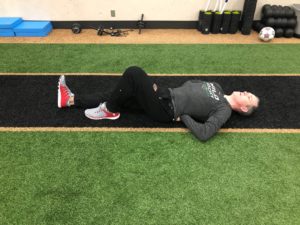
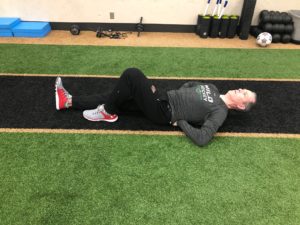
SIDE BRIDGE
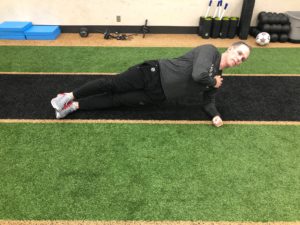
BIRD DOG
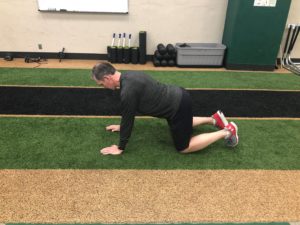
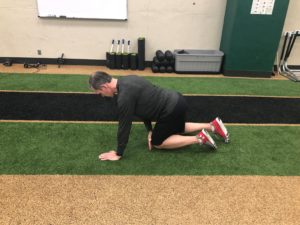
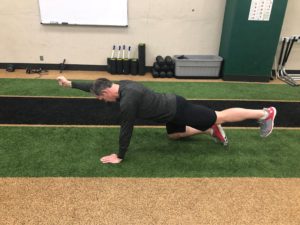
What about Skating? As I mentioned before, I believe that less than adequate skating technique can contribute to Bantam Back. I think that after the 3-month long break, the player needs to be with a good skating coach to help the player possibly re-learn skating technique. The fundamental position of skating needs to be emphasized so that lower back health isn’t compromised. This combined with proper strength and conditioning off the ice can contribute to the player returning back to their normal level of play. I have personally seen kids come back to skate and play again at a higher level.
Again, sometimes an injury like this can be a blessing in disguise. It may sound crazy, but it is 3 months forced rest. Unfortunately, some kids need that today. A young athlete competing year round combined with less attention to technique can be as a recipe for something like this.
- https://www.acefitness.org/cmes-resources/pdfs/02-10-CMES-McGillsTorsoEnduracneTest.pdf
- https://www.livestrong.com/article/392341-stuart-mcgills-big-three-back-exercises/
As I am working in my 18th year with a professional hockey franchise, I want to share my thoughts on working with a team. There are lots of perceptions and outside opinions from others on the way that things should be done. However, I think that when you do have experience, I think you can have a reason for doing some of the things the way that you do.
Earlier in my career, I worked with collegiate hockey teams. I would train the team as one group. This would mean that every player is doing the exact same program. However, individual modifications and regressions have always been made to certain exercises for certain individuals. These changes were made based on the athlete’s requirements. Most of the time this may have been due to a previous or a current injury that would prevent the athlete from doing what other team members were doing. This was done on a year-round basis. When I entered the professional environment, I kept that same philosophy. The reality is that I still do today.
There has been some criticism of this in the past from some athletes and other professionals. “Why am I doing the same program as him?” or “Shouldn’t each player have their own program?”. When I think of the individual needs of athletes, why does one athlete need more of something while another needs less- in-season? Sure, there are individual needs to be met with some of our results of measurements that we administer. Also, we do have athletes who do something in addition to our template, but the template is still the template for the team.
Today, the majority of my work with our athletes is done in-season. This is due to the fact that professional athletes aren’t required to do what the team provides them with during the off-season. We have some athletes who will follow our program. However, most of them hire their own personal trainers for the off-season. In-season is entirely different.
In season, we train as a team. This includes warm ups and strength training workouts. I believe that there is a benefit to teammates working together- both on and off- the ice. The way I always look at it is that I want to decrease the chance of injuries and increase performance the best that I possibly can. Given the logistics of the professional hockey schedule, there are always going to be challenges. To me, putting together the template is part of the art of coaching. Our workouts are quick and efficient, especially post-game when our athletes’ time is valuable.
Some of the best players that I have been fortunate to work with didn’t/don’t necessarily enjoy strength and conditioning. What I have found is that the good and great ones don’t necessarily have to enjoy it but they understand the “Why” and embrace it.
When the leaders and your best players on your team understand the importance of why they are training, then it is easy for the rest of the team to understand as well. The more time we can train as a team is better for us in the long run.
Here is a recent interview that I did with Made Hockey.
I wanted to write about something that I have seen happen over the last 5-10 years in the hockey training realm. Before I express my view, it’s important to note that I am a strength and conditioning coach. My work is primarily off the ice.
I believe young hockey players are skating too much during the off-season. I understand the reasoning for professional players to be on the ice on a year-round basis. They can perfect their craft while also improving or maintaining their conditioning. As pro’s get older, they may not like the pounding of training on land (i.e. running). Although I do believe that pros would benefit from running and extending their hips more in the off-season, I understand where they are coming from. With most pro’s nowadays, there was a time when they were involved in a structured strength and conditioning program while not skating as much.
I believe the issue is with players at the high school level or below. I am not talking about tryouts or other evaluation programs. I am referring to the daily 1-2 hour long skating sessions that can occur 1-2 times per day, 5-6 days per week.
I am not advocating for no skating as I do believe that some on-ice work is appropriate. Skating specific drills to improve crossovers, change of direction, and stride length all have a place. I question when the volume of the on-ice work interferes with the physical development of the young player.
Here are some of my reasons
- Strength training workouts are stressful. There has to be time to recover between workouts as muscles are damaged through strength training. They need time to repair and grow. Younger athletes may not need as long of a recovery time as adults. I do believe that it isn’t beneficial when a young athlete is in a 4-day per week strength and conditioning program and a 5-6 day per week skating program at the same time. You will not get the most out of your training on or off the ice.
- Increasing force production will help you get faster. Strength training will help increase leg strength which will help increase force production when you skate. The more force you can push into the ice, the faster you will go. The key would be to get progressively stronger during the off-season which may not happen if the athlete doesn’t recover between workouts.
- Don’t skip strength and conditioning for skating. It’s hard to convince parents to have their child skip the skating sessions to get their strength and conditioning in. I understand that tryouts maybe approaching or the opportunity to work with a highly regarded skills coach is important. However, most of the time, I think it comes down to parents feeling like their kid will miss out. (Unfortunately, I’ve been there as a parent). I do believe that in the long run, the strength and conditioning session will be more beneficial. Make strength and conditioning the priority or at least don’t schedule your lifting and skating at the same time of day.
- Communication with skating coaches is important. Skating coaches and strength and conditioning coaches should communicate frequently. It would be beneficial to know what the skating coach’s plans are for the day and vice versa.
While I am always going to push for adequate recovery time between workouts, the reality is that I think kids are going to be on the ice more and more. Again, I am not advocating for being off the ice completely during the summer months. Two to three sessions per week while working on a specific skill is fine. I do think there is an issue with kids and parents trying to juggle too many things such as strength and conditioning, high school captain’s practice, power skating, and week-long drop in sessions.
Off-season on-ice work with a good coach is beneficial when combined with a strength and conditioning program. Lower body strength training, plyometrics, and sprinting can help a hockey player become a better skater. A good skating coach can help you improve your skating position and speed in conjunction with a good strength and conditioning program as long as rest and recovery is integrated.
Here is a recent podcast that I did with my friend Matt Riley. It was a lot of fun to catch up with Matt and talk about hockey and strength and conditioning.
I originally wrote this a few years ago. Looking back, I still feel the same.
Today’s hockey players are becoming bigger, stronger, and faster while becoming more fit than they were in years past. In addition to young players participating in other sports, they are also participating in strength and conditioning programs either at their own school, with their team, or with private training companies that are in the communities.
Strength and conditioning for sports has now become a common necessity that really wasn’t around until recently. It has now become a business as there are now several training facilities within every neighborhood.
With the sports training market becoming very saturated, there are several to choose from when it comes to choosing one for your son or daughter. Like any other businesses, in my opinion, there are some very good ones, some average ones, and some not so good ones. What I have listed below are some quick guidelines on making a selection for a strength and conditioning coach/personal trainer or company. These are based on observations and opinions about today’s hockey players and performance:
1- Make sure that the trainer(s) has a degree from a 4-year college/university. A master’s degree would be a plus. Preferably, their degree is in Exercise Science, Kinesiology, Biomechanics, or any other major related to Exercise and or Sports Medicine.
2- Make sure that the trainer is certified by a reputable certification agency. For Strength and Conditioning Coaches or Personal Trainers who work with hockey players, the Certified Strength and Conditioning Coach (C.S.C.S) certification from the National Strength and Conditioning Association (NSCA) is probably the most reputable certification. Another good certification is any certification provided by the National Academy of Sports Medicine (N.A.S.M.).
3- Ask for testimonials and/or references from athletes that they have coached. They should be able to provide current or past testimonials from people who have trained with them. If they can’t provide you with any testimonials, ask for references. If they can’t give you any references, find another trainer. Also, make sure that the trainer actually trained and worked with an athlete who they say they may have.
4- Don’t get caught up in the “bells and whistles” about the facility. Most of the good strength and conditioning coaches and personal trainers out there can get results without the high-tech equipment which may be considered “hockey-specific”. Also, they may not need a large facility the size of a Wal-Mart.
In today’s world, it is easy for anyone to get a personal training certification from a non-reputable source and then partner up with someone with a lot of money and start up a sports training business. I would always prefer an individual or company that started out with close to nothing and then grew their business by getting positive results from their athletes and clients. As a parent who is paying for the child to participate in a strength and conditioning program, you must do your homework when trying to choose one. Hopefully these guidelines and recommendations will help you make the right decision
I wrote this a while back and it was posted on StrengthCoach.com. I may post some others that aren’t on this site.
The goals of the pre-season strength and conditioning phase for hockey are 1- To help prepare for the demands of training camp and 2- To bridge the gap between the off-season and in-season strength and conditioning phases. At the collegiate and professional levels, this is a unique time for the Strength and Conditioning Coach because it is when most of the players are present for strength and conditioning sessions. With the fact that many athletes could be in different locations throughout the off-season, this a great time to get the entire team together and implement the program and help build team camaraderie.
The pre-season phase is usually 3-4 weeks in duration and occurs from late August through early September. We will spend 3 days in the weight room and 4-5 days on-ice on a weekly basis. Strength training will take place prior to skating on Monday, Wednesday, and Friday while conditioning on the bike is completed prior to skating on Tuesday and Thursday. Skating is Monday through Friday.
During this phase, more volume is implemented. This is much different from the early off-season phase when training is primarily off-ice. Some of the training methods that were done in the off-season will be discontinued. This includes running and slideboarding. The conditioning focus is on-ice speed and conditioning with the exception of 2 bike workouts per week.
Strength Training
The strength training philosophy during this period will consist of circuit training. This is different from any other time of year. Instead of doing 5-6 strength and power exercises, we will now do 12 exercises straight through. When the circuit starts, the rest periods between exercises will be determined by how many athletes are present. For example, if there are 24 athletes, we will partner up at each exercise and go at a simple I go-you go pace. Each athlete and partner is assigned an exercise/station from 1-12 and then they will follow along. There is a 1 minute and 30 second rest period when the circuit is completed.
I have found that putting the exercises in this order has worked best: double leg push, upper pull (vertical), upper push (horizontal), core/anterior chain, lower explosive, 1-Leg lower push, upper pull (horizontal), upper press (vertical), 1-leg lower (glute/hamstring emphasis), 1-arm upper pull, core/stabilization, and upper explosive. We will perform these circuits 2 x per week on Monday’s and Friday’s. The difference between the Monday and Friday circuit is that although the format of movements will stay the same, the selection of exercise will be different. For example, on Monday we may perform a pull up (hands facing away) while we may perform a chin up on Friday (palms facing). On Wednesdays, we will perform a plate circuit which is borrowed/stolen from Strength and Conditioning Coaches Mike Boyle and the Calgary Flames’ Rich Hesketh.
During the Monday and Friday circuits, each player will perform the prescribed number of reps for each exercise in the circuit. Regressions are implemented for athletes who may not be able to perform a specific exercise due to reasons such as past injuries and/or biomechanical deficiencies. For example, we may substitute a goblet squat for the front squat or a split squat instead of the 1-leg squat.
During the Wednesday circuit, each player will be given a 35-lb plate and complete the entire circuit without resting. This will take place for each exercise until the steering wheel exercise in which all of the athletes perform it together.
Conditioning
The off-ice conditioning will take place on the stationary bikes Tuesdays and Thursdays. On Tuesdays, the bike sessions will consist of 1-minute sprints at a high level of resistance. During these sprints, we are trying to enhance the player’s resistance to fatigue- especially after the 30-40 second mark in which the average hockey shift ends. At the end of the sprint, they will recover to 130 bpm while at level 1 on the bike. We will start with 6 reps in week 1 and add one more rep each week. On Thursdays, we will simply perform a steady state/cardiac output ride where the emphasis is on keeping the heart rate in the 130-140bpm range. This ride is to help increase cardiac output and enhance our ability to recover. We will typically go for 30-60 minutes. Saturday bike rides will be prescribed based on how the player feels and what his needs may be.
On the ice, the players will run their own practices. They will perform 45 minutes of drills and then follow up with a 45 minute scrimmage. On Fridays during the preseason, players prepare for the training camp conditioning test at the end of practice. The conditioning test is very demanding and requires serious preparation. Not only do the players get prepared for the test, but they are getting some conditioning work in during the process.
What I really like about pre-season workouts is that there is full participation from everyone on the team. The players believe in the program and the importance of training together for team building. This is a great phase because it can help establish the culture of the strength and conditioning program prior to the in-season phase. The Strength and Conditioning Coach can coach and interact with the athletes while making a smooth transition into the in-season phase.
As I continue my career in professional hockey, the process of getting your athletes to buy in and participate in the program is much more important than providing them with a “state of the art” program that not everyone will want to do. I believe that when you provide them with a basic program in an environment where they are training hard together, the results can be positive from an on-ice perspective.
I like to read books all the time- although I probably don’t read as much as others. Here are some of the books that I have read recently and have almost finished:
Tough to say that this is a book that I am reading but I did purchase it and do read the words on the page on a daily basis. I enjoy starting my day with gratitude writing. I have tried a few of them but I wanted to try a new process. So far so good.
Iron Works Preparation: The Best Way to Prepare for Football
I have really enjoyed listening to Arizona Cardinals Strength and Conditioning Coach Buddy Morris on several different podcasts. I have also read some of his “Coach X” material on Elitefts.com. This book (which is co-authored by Ryan Williams)was another way to see how good strength and conditioning coaches organizes their thoughts and write programs. I am a nerd when it comes to this stuff and enjoy learning how other coaches write programs even if it isn’t for hockey.
Gift of Injury
This is a great resource for me because I have low back pain. I am also always looking for methods that work in the prevention of LBP in my athletes/clients. I have read lots of Stuart McGill’s work but this was different because it was written from Dr. Mcgill’s perspective as well as the athlete’- Brian Carroll. I had the opportunity to meet with Brian at the the annual PHATS meeting in Orlando. It was pretty neat to hear his experience.
Thinking, Fast and Slow
I had a good start with this and I put it down because I found it to be a tough read. I anticipate picking it up again soon.
Would love to hear thoughts and suggestions.
Here is a link to a recent podcast that I did with Steve Breitenstein from TCBoost Sports Performance:
https://itunes.apple.com/us/podcast/the-speed-podcast/id1333698295?mt=2
I had fun participating. I hope you enjoy it!
